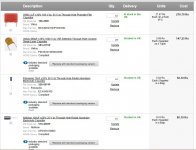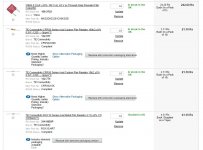ClassAB amplifiers vary the ripple as the output current changes.
There is no point in "designing for a fixed ripple" when there is a moving target.
ClassA are no better, except that the quiescent current draw is so high that the change is ripple becomes much less as a proportion.
There is no point in "designing for a fixed ripple" when there is a moving target.
ClassA are no better, except that the quiescent current draw is so high that the change is ripple becomes much less as a proportion.
This is my version of this amp. I finished today. It sounds great !
Check the schematics in atasament. What do you think ?
Check the schematics in atasament. What do you think ?
An externally hosted image should be here but it was not working when we last tested it.
An externally hosted image should be here but it was not working when we last tested it.
An externally hosted image should be here but it was not working when we last tested it.
An externally hosted image should be here but it was not working when we last tested it.
An externally hosted image should be here but it was not working when we last tested it.
Attachments
Hi all,
I am planning to build an amp with Apexaudio circuit and I am about to order the caps and resistors. Since I am a beginner, could someone tell me if the parts (as given in the attached images) are of adequate/correct specs? I dont really understand the different types of caps , hence need some help in choosing the correct components.
regards
prasi
I am planning to build an amp with Apexaudio circuit and I am about to order the caps and resistors. Since I am a beginner, could someone tell me if the parts (as given in the attached images) are of adequate/correct specs? I dont really understand the different types of caps , hence need some help in choosing the correct components.
regards
prasi
Attachments
The Y5R is probably wrong.
What is it for?
The 25V 100uF may be OK.
What voltages does it operate at?
Carbon film resistors are generally not suitable. Metal film are better and as a second choice Metal oxide.
What is it for?
The 25V 100uF may be OK.
What voltages does it operate at?
Carbon film resistors are generally not suitable. Metal film are better and as a second choice Metal oxide.
Hi Andew,
Thanks for the reply. even I feel that the Y5R specs are wrong 1000V?... its for the 680pF caps as per the apex audio schematic on page 1 of the thread. I will try and see if I can get hold of metal film resistors.
reg
prasi
Thanks for the reply. even I feel that the Y5R specs are wrong 1000V?... its for the 680pF caps as per the apex audio schematic on page 1 of the thread. I will try and see if I can get hold of metal film resistors.
reg
prasi
The sch does not tell me which is the 680pF !
I'll guess, since you didn't tell me either, that the 680pF is the RF attenuator capacitor C2
This can be a silvered mica, or a polystyrene, or a polypropylene, or a NP0/C0G ceramic. I would choose either a polypropylene, or an NP0.
Now show me what the duties and operational voltages of the other capacitors are and I will try to guide you.
I'll guess, since you didn't tell me either, that the 680pF is the RF attenuator capacitor C2
This can be a silvered mica, or a polystyrene, or a polypropylene, or a NP0/C0G ceramic. I would choose either a polypropylene, or an NP0.
Now show me what the duties and operational voltages of the other capacitors are and I will try to guide you.
pl see the second attachment (is it called layout?, I am a beginner!)and also the parts list mentioned by Apex audio which i guess is somewhere on page 3 of the thread.
As I said, i am a beginner, I dont know the functions and operational voltages of any of the components, hence i am following somebody's work (APEX audio in this case) and trying to build a system for myself that sounds better than chepo commercial amps.
As I said, i am a beginner, I dont know the functions and operational voltages of any of the components, hence i am following somebody's work (APEX audio in this case) and trying to build a system for myself that sounds better than chepo commercial amps.
Why should I have reverse engineer the PCB layout back to the schematic to identify the components in an attempt to help you?
dont. nobody is forcing you to andrew. All i am asking through this thread, those who have already built the circuit to help me in selecting proper types of the components, as i am a beginner (in plain english...)
Its a simple enough circuit, right? What can possibly go wrong?... to start with we have so many success stories... then the schematics(post no.#43), PCB layout showing traces and component values (post#240). I only wanted to select correct type of caps for the circuit. With resistors, you corrected me to use metal film /oxide rather than carbon film. thanks for that.
regards
prasi...
regards
prasi...
Just to share one of my favorite APEX collections LM3886 Chip Amplifer...
I can't stop my self to build again and again.....😀
I enjoy a lot with this very very nice amplifier of APEX
Regards,
hi do you have the .brd and gerber file for the above board?
Just to share one of my favorite APEX collections LM3886 Chip Amplifer...
I can't stop my self to build again and again.....😀
I enjoy a lot with this very very nice amplifier of APEX
Regards,
Hi Do you still have the .brd or gerber file of the APEX LM3886 PCB.? I would like to use the same file to get some PCB's printed. Pl help.
reg
prasi
- Home
- Amplifiers
- Chip Amps
- LM3886 Schematics + PCB


